SEO
Game-Changers for Your Website Traffic and Rankings

Keywords, as we all know, are the bread and butter of SEO. They are how potential customers find us online and are what we build entire strategies around.
But targeting the best keywords for your business is tough. Short tail keywords are attractive, but are often too competitive, too high volume for most to fight for—so what is the alternative?
Here’s where long-tail keywords come in. They provide an untapped opportunity to drive more relevant traffic to your website and connect with customers further along their purchase journey.
In this article, we’ll dive deep into the essence of long-tail keywords, examining their importance, advantages, and—most importantly—how to incorporate them effortlessly into your content strategy.
What is a Long-Tail Keyword?
Long-tail keywords in SEO are keyword phrases with more than three words that are extremely focused and specialized. These keywords are more targeted and reflect users’ exact search intentions than generic or broad-based keywords. They can also provide users with a more customized search experience.
The Power of Precision
When you are conducting keyword research, you can specifically target the wants and demands of your target market. You may draw readers who are more likely to convert by including these certain terms in your article.
For instance, if you own a running shoe business, it will be very difficult to rank at the top for the keyword “best running shoes,” much less gain much traffic from your efforts.
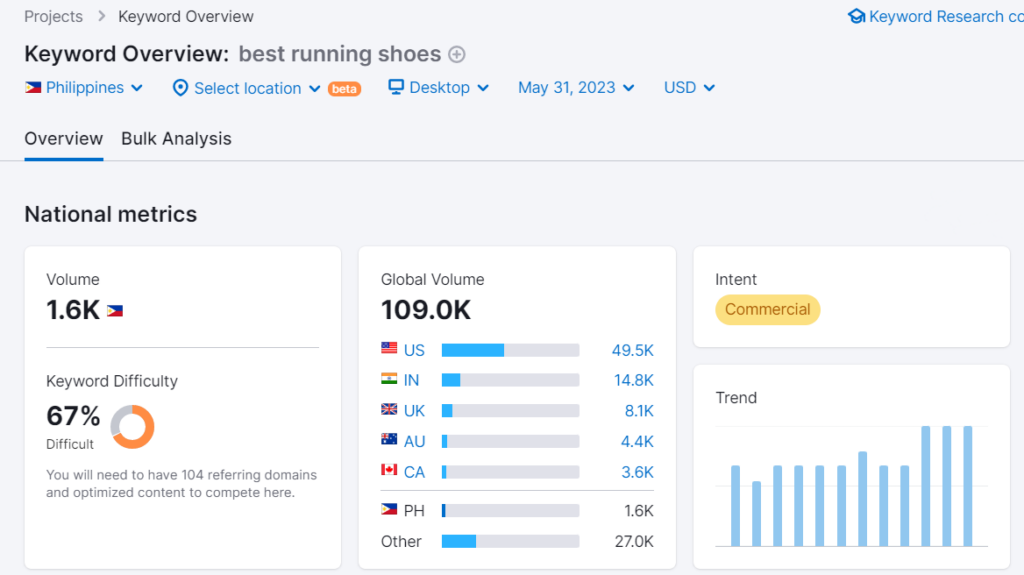
If, however, you decide to target the keyword “women’s running shoes for wide feet” instead, then you are more likely to draw highly interested customers who are looking for that exact product.
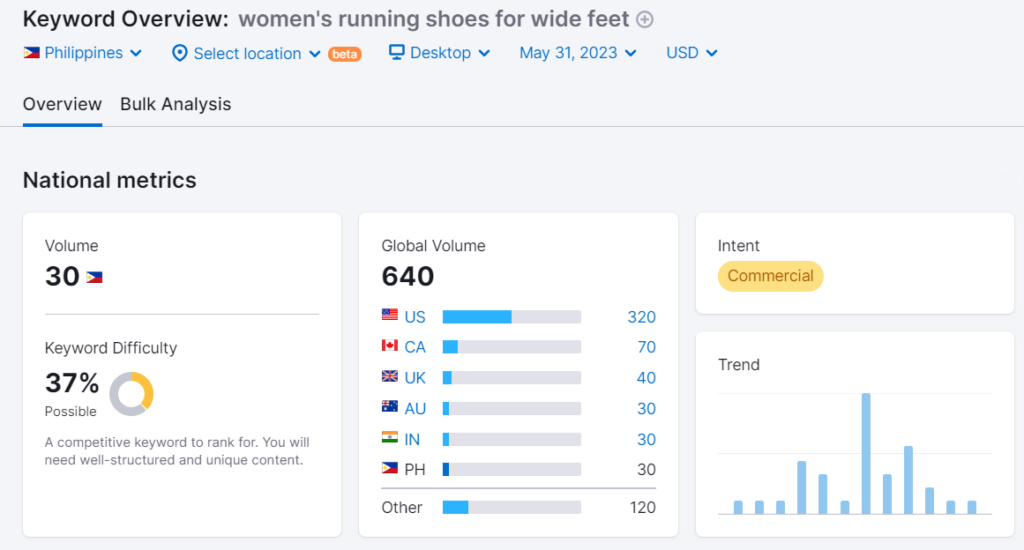
After all, when someone enters that very long, very specific keyword, they are demanding one thing: the kind of product that they just searched for on Google.
By positioning yourself as someone who can answer their demand, you grab their attention, answer their search question, and ultimately bring in users who are more likely to buy your product.
There is a value of precision that specific keywords provide. You may attract people who have a precise aim and are inclined to become clients by using such focused terms.
Less Competition=Less Cost
Though these keywords often have lower search volumes since they are more specific than short tail or broad keywords, there often are fewer opponents for this from other websites.
In that sense, you can also easily rank at the top of search engine results pages (SERPs) for these keywords, and attract more customers by focusing on untapped niches in a crowded online market.
So, this level of specificity of the keyword not only helps you reach a particular target audience but also distinguishes you from your competitors who may only optimize for broader keywords like “best running shoes.”
By catering to the needs and preferences of your audience, you also position your website as a trusted and reliable source for those looking for that particular product.
Providing people with exactly what they’re looking for will allow you to gain traffic almost effortlessly in a less competitive space, and drive conversions on your website.
What is an Example of a Long-Tail Keyword?
To further comprehend the idea of what a long-tail keyword is, let’s look at an example.
Consider a bakery that specializes in making desserts and sweets without gluten.
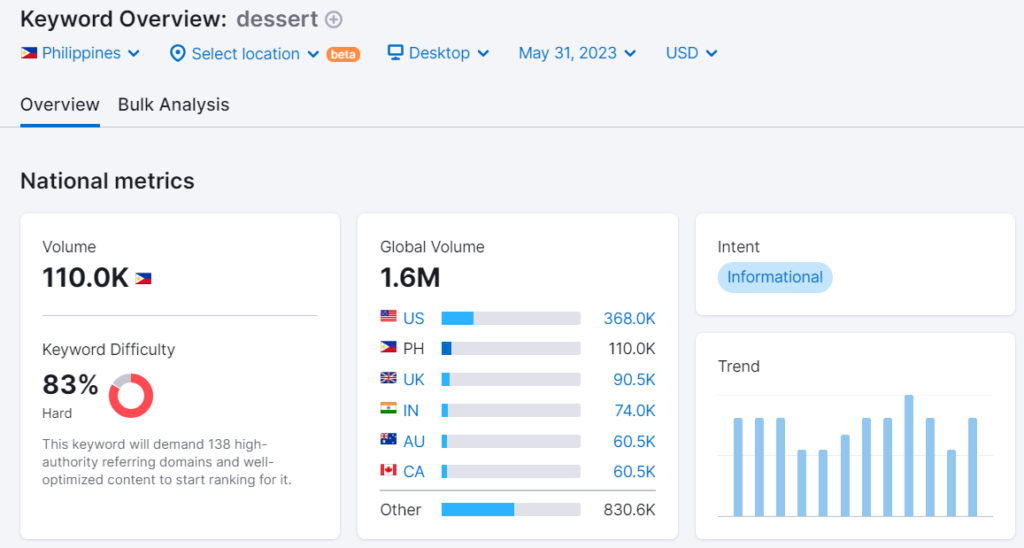
Instead of optimizing your website for a short tail keyword like “dessert,” an extended keyword example you might consider is “gluten free chocolate chip cookies.”
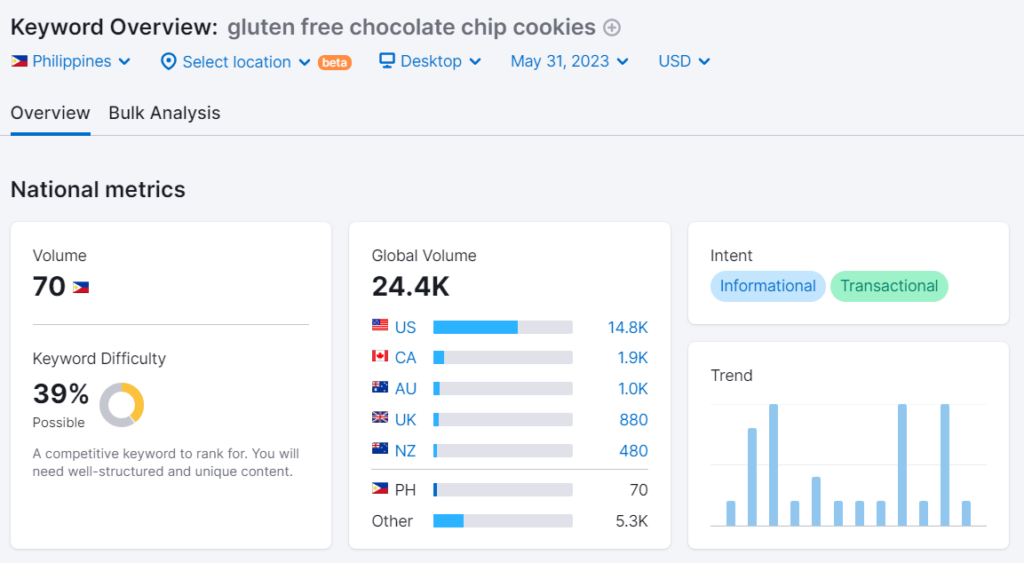
This phrase is extremely particular, addressing the dietary needs of a smaller audience looking for a particular type of dessert.
Aside from dietary needs, another way to find long-tail keywords is to look at the preferences of a potential customer. Things like flavor, color, or size can lead to a long-tail keyword. A customer might look for “mini chocolate frosted cupcakes,” which is another area you could target.
In short, almost every descriptor or variation of the products you offer is a long-tail keyword that you can potentially target.
Why Should You Integrate Long-Tail Keywords in Your Blog Posts?
Using long-tail keywords doesn’t just have to be on your website pages—it’s a great strategy for your monthly blogs, too.
Integrating these in your blog posts can have a significant impact on both your entire content plan and SEO efforts.
Focused Traffic
As I said earlier—these keywords reveal users’ intentions when they look for certain knowledge, goods, or services.
You can draw readers who are more interested in your content and offers by including long-tail keywords in your blog entries.
These users are also often further along in the purchasing process, which increases their likelihood of becoming customers.
You can direct targeted visitors to your blog and improve your chances of accomplishing your conversion goals by tailoring your content to their particular demands.
Enhanced Relevance
By focusing on writing for long-tail keywords, you can produce content that is incredibly relevant to the particular wants and needs of your target audience. You can satisfy their expectations by providing them with useful and informational blog entries by answering their specific questions.
This can also position your blog post as a reliable source of information in SERPs—usually in the form of a featured snippet or rich result for that search query.
Improved Search Rankings
High competition makes it difficult to rank highly in the search results for short, generalized keywords.
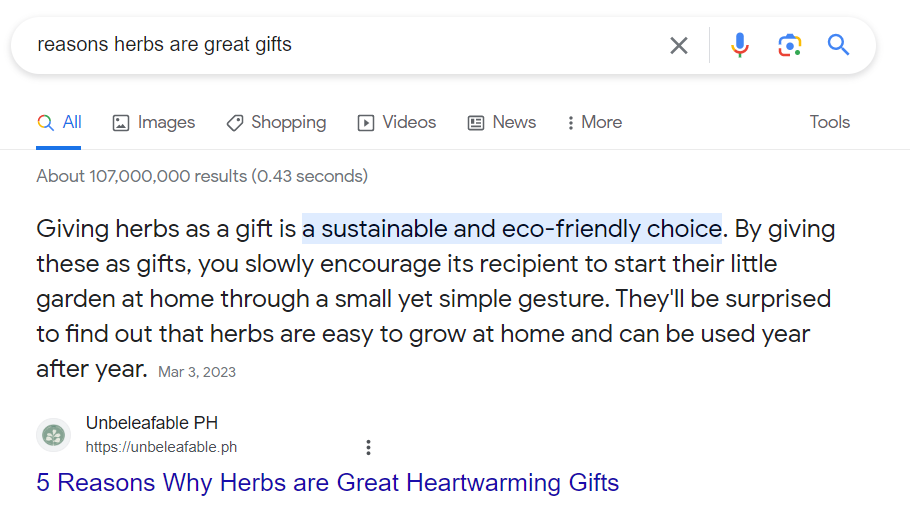
On the other hand, long keywords frequently have a lower search volume and face fewer competitors. By targeting these, you drive better results for much less effort and time spent. This is especially helpful if you work in a cutthroat industry.
You can quickly build your online presence, improve your exposure, and increase organic blog traffic by concentrating on long keyphrases.
When Should You Use Long-Tail Keywords in Your SEO?
To maximize their impact, long keyphrases must be used in the right situations within your SEO plan.
Here are some pointers on when you should use these keywords.
Niche Targeting
Long-tail keywords might help you more successfully reach your target market if your company works in a particular niche or caters to a specialized demographic. Although they could draw in a larger audience, generic keywords do not guarantee that they will be interested in your particular services.
You may boost your chances of bringing in highly relevant traffic by selecting keywords that represent the particular demands, preferences, or pain points of your audience.
For instance, if you sell eco-friendly yoga mats, you may reach yoga practitioners who are concerned about the environment and are looking for sustainable products by optimizing your SEO using long keywords like “natural rubber non-toxic yoga mats.”
Entering Competitive Industries
In highly competitive industries, it might be difficult to rank effectively for generic keywords in highly competitive sectors. Long-tail keywords provide you the chance to stand out and draw in a smaller but more intent audience.
You might find several long-tail keywords once you start your competitors’ analysis. When you do, you’ll see that the difficulty of targeting these is low, since they have lower search volumes and fewer people actively trying to rank for them.
This may be a golden opportunity for you—you can enter your industry through what is essentially a side door. Take gaming laptops, for example, where your website could enter by marketing your “thin and light budget gaming laptops.”
Focusing on a very specific part of the market can draw visitors who are actively looking for the exact goods, services, or information you provide. And, before you know it, you’ll have secured territory in a competitive arena.
Content Optimization
I said earlier that long-tail keywords are great for blog posts, and this plays into a larger strategy for content optimization.
Users frequently utilize longer and more precise keyword phrases while looking for information or solutions to their problems. You can give thorough and specific responses to these questions by including long keywords in your blog posts, articles, and FAQ sections.

Providing useful material not only enhances user experience but also helps address any content gaps your posts or pages may have. They can help you establish authority in your field and draw in people looking for in-depth information by including them in your content optimization plan.
Key Takeaway
Long-tail keywords are a potent optimization technique that increases conversion rates and drives focused visitors. You attract interested visitors who are more inclined to take action by concentrating on precise, pertinent keywords. These keywords provide you with a huge competitive advantage simply because of how targeted and exact they are.
Maximize your SEO potential now with long-tail keywords. Take charge of your website’s visibility, attract highly engaged visitors, and drive conversions like never before.
SEO
Google Cautions On Blocking GoogleOther Bot

Google’s Gary Illyes answered a question about the non-search features that the GoogleOther crawler supports, then added a caution about the consequences of blocking GoogleOther.
What Is GoogleOther?
GoogleOther is a generic crawler created by Google for the various purposes that fall outside of those of bots that specialize for Search, Ads, Video, Images, News, Desktop and Mobile. It can be used by internal teams at Google for research and development in relation to various products.
The official description of GoogleOther is:
“GoogleOther is the generic crawler that may be used by various product teams for fetching publicly accessible content from sites. For example, it may be used for one-off crawls for internal research and development.”
Something that may be surprising is that there are actually three kinds of GoogleOther crawlers.
Three Kinds Of GoogleOther Crawlers
- GoogleOther
Generic crawler for public URLs - GoogleOther-Image
Optimized to crawl public image URLs - GoogleOther-Video
Optimized to crawl public video URLs
All three GoogleOther crawlers can be used for research and development purposes. That’s just one purpose that Google publicly acknowledges that all three versions of GoogleOther could be used for.
What Non-Search Features Does GoogleOther Support?
Google doesn’t say what specific non-search features GoogleOther supports, probably because it doesn’t really “support” a specific feature. It exists for research and development crawling which could be in support of a new product or an improvement in a current product, it’s a highly open and generic purpose.
This is the question asked that Gary narrated:
“What non-search features does GoogleOther crawling support?”
Gary Illyes answered:
“This is a very topical question, and I think it is a very good question. Besides what’s in the public I don’t have more to share.
GoogleOther is the generic crawler that may be used by various product teams for fetching publicly accessible content from sites. For example, it may be used for one-off crawls for internal research and development.
Historically Googlebot was used for this, but that kind of makes things murky and less transparent, so we launched GoogleOther so you have better controls over what your site is crawled for.
That said GoogleOther is not tied to a single product, so opting out of GoogleOther crawling might affect a wide range of things across the Google universe; alas, not Search, search is only Googlebot.”
It Might Affect A Wide Range Of Things
Gary is clear that blocking GoogleOther wouldn’t have an affect on Google Search because Googlebot is the crawler used for indexing content. So if blocking any of the three versions of GoogleOther is something a site owner wants to do, then it should be okay to do that without a negative effect on search rankings.
But Gary also cautioned about the outcome that blocking GoogleOther, saying that it would have an effect on other products and services across Google. He didn’t state which other products it could affect nor did he elaborate on the pros or cons of blocking GoogleOther.
Pros And Cons Of Blocking GoogleOther
Whether or not to block GoogleOther doesn’t necessarily have a straightforward answer. There are several considerations to whether doing that makes sense.
Pros
Inclusion in research for a future Google product that’s related to search (maps, shopping, images, a new feature in search) could be useful. It might be helpful to have a site included in that kind of research because it might be used for testing something good for a site and be one of the few sites chosen to test a feature that could increase earnings for a site.
Another consideration is that blocking GoogleOther to save on server resources is not necessarily a valid reason because GoogleOther doesn’t seem to crawl so often that it makes a noticeable impact.
If blocking Google from using site content for AI is a concern then blocking GoogleOther will have no impact on that at all. GoogleOther has nothing to do with crawling for Google Gemini apps or Vertex AI, including any future products that will be used for training associated language models. The bot for that specific use case is Google-Extended.
Cons
On the other hand it might not be helpful to allow GoogleOther if it’s being used to test something related to fighting spam and there’s something the site has to hide.
It’s possible that a site owner might not want to participate if GoogleOther comes crawling for market research or for training machine learning models (for internal purposes) that are unrelated to public-facing products like Gemini and Vertex.
Allowing GoogleOther to crawl a site for unknown purposes is like giving Google a blank check to use your site data in any way they see fit outside of training public-facing LLMs or purposes related to named bots like GoogleBot.
Takeaway
Should you block GoogleOther? It’s a coin toss. There are possible potential benefits but in general there isn’t enough information to make an informed decision.
Listen to the Google SEO Office Hours podcast at the 1:30 minute mark:
Featured Image by Shutterstock/Cast Of Thousands
SEO
AI Search Boosts User Satisfaction

A new study finds that despite concerns about AI in online services, users are more satisfied with search engines and social media platforms than before.
The American Customer Satisfaction Index (ACSI) conducted its annual survey of search and social media users, finding that satisfaction has either held steady or improved.
This comes at a time when major tech companies are heavily investing in AI to enhance their services.
Search Engine Satisfaction Holds Strong
Google, Bing, and other search engines have rapidly integrated AI features into their platforms over the past year. While critics have raised concerns about potential negative impacts, the ACSI study suggests users are responding positively.
Google maintains its position as the most satisfying search engine with an ACSI score of 81, up 1% from last year. Users particularly appreciate its AI-powered features.
Interestingly, Bing and Yahoo! have seen notable improvements in user satisfaction, notching 3% gains to reach scores of 77 and 76, respectively. These are their highest ACSI scores in over a decade, likely due to their AI enhancements launched in 2023.
The study hints at the potential of new AI-enabled search functionality to drive further improvements in the customer experience. Bing has seen its market share improve by small but notable margins, rising from 6.35% in the first quarter of 2023 to 7.87% in Q1 2024.
Customer Experience Improvements
The ACSI study shows improvements across nearly all benchmarks of the customer experience for search engines. Notable areas of improvement include:
- Ease of navigation
- Ease of using the site on different devices
- Loading speed performance and reliability
- Variety of services and information
- Freshness of content
These improvements suggest that AI enhancements positively impact various aspects of the search experience.
Social Media Sees Modest Gains
For the third year in a row, user satisfaction with social media platforms is on the rise, increasing 1% to an ACSI score of 74.
TikTok has emerged as the new industry leader among major sites, edging past YouTube with a score of 78. This underscores the platform’s effective use of AI-driven content recommendations.
Meta’s Facebook and Instagram have also seen significant improvements in user satisfaction, showing 3-point gains. While Facebook remains near the bottom of the industry at 69, Instagram’s score of 76 puts it within striking distance of the leaders.
Challenges Remain
Despite improvements, the study highlights ongoing privacy and advertising challenges for search engines and social media platforms. Privacy ratings for search engines remain relatively low but steady at 79, while social media platforms score even lower at 73.
Advertising experiences emerge as a key differentiator between higher- and lower-satisfaction brands, particularly in social media. New ACSI benchmarks reveal user concerns about advertising content’s trustworthiness and personal relevance.
Why This Matters For SEO Professionals
This study provides an independent perspective on how users are responding to the AI push in online services. For SEO professionals, these findings suggest that:
- AI-enhanced search features resonate with users, potentially changing search behavior and expectations.
- The improving satisfaction with alternative search engines like Bing may lead to a more diverse search landscape.
- The continued importance of factors like content freshness and site performance in user satisfaction aligns with long-standing SEO best practices.
As AI becomes more integrated into our online experiences, SEO strategies may need to adapt to changing user preferences.
Featured Image: kate3155/Shutterstock
SEO
Google To Upgrade All Retailers To New Merchant Center By September

Google has announced plans to transition all retailers to its updated Merchant Center platform by September.
This move will affect e-commerce businesses globally and comes ahead of the holiday shopping season.
The Merchant Center is a tool for online retailers to manage how their products appear across Google’s shopping services.
Key Changes & Features
The new Merchant Center includes several significant updates.
Product Studio
An AI-powered tool for content creation. Google reports that 80% of current users view it as improving efficiency.
This feature allows retailers to generate tailored product assets, animate still images, and modify existing product images to match brand aesthetics.
It also simplifies tasks like background removal and image resolution enhancement.
Centralized Analytics
A new tab consolidating various business insights, including pricing data and competitive analysis tools.
Retailers can access pricing recommendations, competitive visibility reports, and retail-specific search trends, enabling them to make data-driven decisions and capitalize on popular product categories.
Redesigned Navigation
Google claims the new interface is more intuitive and cites increased setup success rates for new merchants.
The platform now offers simplified website verification processes and can pre-populate product information during setup.
Initial User Response
According to Google, early adopters have shown increased engagement with the platform.
The company reports a 25% increase in omnichannel merchants adding product offers in the new system. However, these figures have yet to be independently verified.
Jeff Harrell, Google’s Senior Director of Merchant Shopping, states in an announcement:
“We’ve seen a significant increase in retention and engagement among existing online merchants who have moved to the new Merchant Center.”
Potential Challenges and Support
While Google emphasizes the upgrade’s benefits, some retailers, particularly those comfortable with the current version, may face challenges adapting to the new system.
The upgrade’s mandatory nature could raise concerns among users who prefer the existing interface or have integrated workflows based on the current system.
To address these concerns, Google has stated that it will provide resources and support to help with the transition. This includes tutorial videos, detailed documentation, and access to customer support teams for troubleshooting.
Industry Context
This update comes as e-commerce platforms evolve, with major players like Amazon and Shopify enhancing their seller tools. Google’s move is part of broader efforts to maintain competitiveness in the e-commerce services sector.
The upgrade could impact consumers by improving product listings and providing more accurate information across Google’s shopping services.
For the e-commerce industry as a whole, it signals a continued push towards AI-driven tools and data-centric decision-making.
Transition Timeline
Google states that retailers will be automatically upgraded by September if they still need to transition.
The company advises users to familiarize themselves with the new features before the busy holiday shopping period.
Featured Image: BestForBest/Shutterstock
-

 SEARCHENGINES6 days ago
SEARCHENGINES6 days agoBillions Of Google goo.gl URLs To 404 In The Future
-
SEARCHENGINES4 days ago
Daily Search Forum Recap: July 22, 2024
-

 SEARCHENGINES7 days ago
SEARCHENGINES7 days agoGoogle Core Update Coming, Ranking Volatility, Bye Search Notes, AI Overviews, Ads & More
-

 SEO5 days ago
SEO5 days ago11 Copyscape Alternatives To Check Plagiarism
-

 SEO6 days ago
SEO6 days agoGoogle Warns Of Last Chance To Export Notes Search Data
-
SEARCHENGINES3 days ago
Daily Search Forum Recap: July 23, 2024
-

 AFFILIATE MARKETING6 days ago
AFFILIATE MARKETING6 days agoThe Top 5 AI Tools That Can Revolutionize Your Workflow and Boost Productivity
-

 SEO4 days ago
SEO4 days agoSystem Builders – How AI Changes The Work Of SEO















